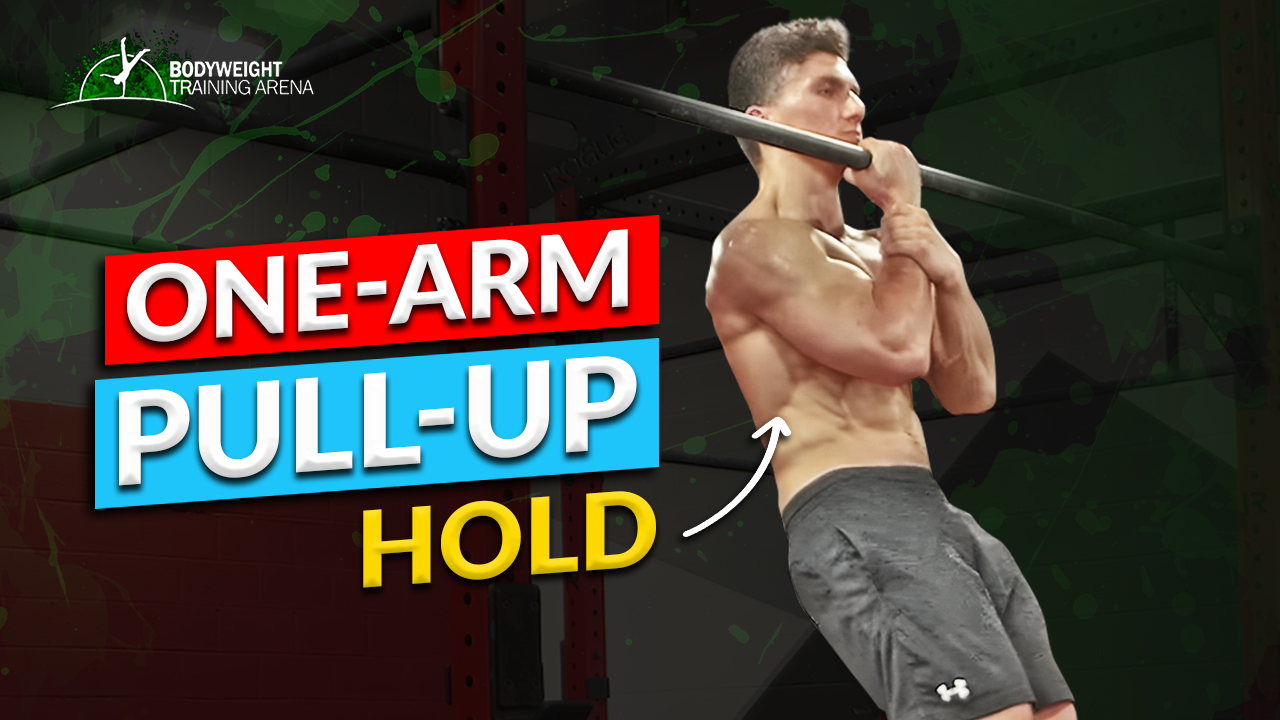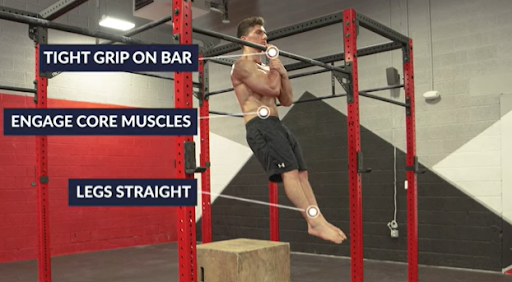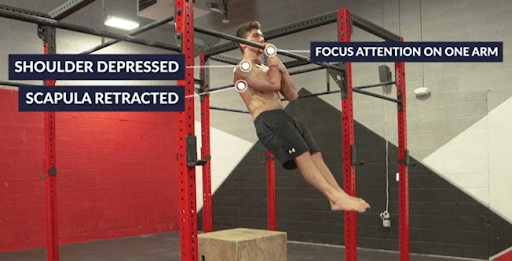Ever wondered what separates a strong upper body from an insanely powerful one?
Enter the one-arm pull-up hold. It’s not just a mere exercise; it’s a testament to sheer strength, control, and that unwavering determination you’ve got tucked under your sleeve.
Often revered as an advanced calisthenics move, this exercise demands not just physical prowess but also mental focus.
Ready to dive in and conquer this challenge? Let’s break down the specifics, target those muscles, unwrap the benefits, and master the technique so you can nail that one-arm pull-up hold like a pro.
🙌What is One-Arm Pull-Up Hold
The one-arm pull-up hold is a challenging bodyweight exercise that involves gripping a horizontal bar with one hand while holding your body in a static position.
Unlike the traditional pull-up where both hands are used, this move focuses on utilizing the strength of a single arm to support your body weight.
It’s not about pulling your body upward; instead, it’s about maintaining a stable position at the top of the pull-up using just one arm. This exercise showcases exceptional upper body strength, stability, and control, demanding significant physical and mental prowess to execute successfully.
Looking to step up your pull-up game? We’ve got some articles that can help boost your routine:
- 📍 Achieve Rapid Progress: A Step-by-Step Guide to Perfect Pull-Ups for Beginners at Home
- 📍 Unveiling the Powerhouse: Muscles Used While Doing Pull-Ups
- 📍 Proper Breathing Techniques for Pull-Ups: Elevate Your Performance!
- 📍 How to Do Pull-Ups Without a Pull-Up Bar: Tips and Tricks
💪Muscles Targeted
From the graceful contraction of the biceps and triceps to the steadfast stability of the core and the robust engagement of the dorsal muscles, every fiber plays a pivotal role in this ultimate showcase of upper-body prowess.
✊Biceps Engagement
Your biceps play an important role in one-arm pull-ups. These upper arm muscles aren’t just for show—they’re the powerhouse behind your ability to lift and stabilize your body during this challenging exercise. Understanding how your biceps integrate into the hold is like unlocking the secret to mastering this impressive feat of strength.
- Initiating the Movement:
The biceps brachii, located on the front of the upper arm, plays a crucial role in the initial pull-up phase. It’s engaged as you begin to lift your body using the one arm gripping the bar.
- Elbow Flexion:
As you pull yourself up, the biceps contract concentrically to flex the elbow, aiding in lifting your body weight.
- Stabilization:
While the biceps play a significant role in the initial lift, they also contribute to stabilizing the arm throughout the hold phase. They help maintain the tension necessary to keep your body steady at the top position.
✊Triceps Involvement:
Situated at the back of your upper arm, these muscles play a pivotal role in supporting and steadying your body throughout this challenging exercise. Understanding their involvement unveils the full spectrum of muscles at work during the one-arm hold.
- Stability and Support:
The triceps brachii provides crucial stability during the one-arm pull-up hold.
- Arm Support:
While the emphasis is on the pulling arm (and thus, the biceps), the triceps of the opposite arm also engage isometrically to support and stabilize the arm that’s not gripping the bar.
- Balancing Force:
Throughout the hold, the triceps work alongside the other muscles to counterbalance the pulling force exerted by the biceps, ensuring equilibrium in the body position.
✊Core Engagement
In the one-arm pull-up hold, your core isn’t a bystander—it’s your anchor. Engaging these central muscles isn’t just about stability; it’s the secret to balancing and controlling your body weight with precision during this challenging exercise. Understanding core engagement is key to mastering the one-arm pull-up hold.
- Stability and Balance:
The core muscles, including the abdominals and obliques, play a pivotal role in stabilizing the body during the one-arm pull-up hold.
- Preventing Rotation:
They assist in resisting any rotational forces, maintaining your body in a straight line, and preventing excessive twisting or swaying while suspended from the bar.
- Overall Control:
A strong core is essential for maintaining control throughout the exercise, allowing you to sustain the hold position with greater stability and balance.
✊Dorsal Muscles Involvement:
Your back muscles are your strength allies. Known as the dorsal muscles, they play a vital role in supporting your body during this challenging exercise. Understanding their involvement sheds light on the comprehensive muscle engagement needed for mastering the one-arm pull-up hold.
- Latissimus Dorsi (Lats):
The lats are powerful muscles in the back engaged in the one-arm pull-up hold, assisting in the pulling action.
- Shoulder Stabilization:
They aid in shoulder adduction and extension, contributing significantly to the pulling strength required for the movement.
- Support and Posture:
The trapezius and rhomboids, alongside the lats, help in stabilizing the shoulder girdle and upper back, ensuring proper posture and alignment while holding the body suspended.
🤔Why Do It?
The one-arm pull-up hold offers a myriad of benefits that extend beyond just showcasing strength. This exercise positively impacts various aspects of your body:
🔥 Grip Strength
- Enhanced Grip Endurance: Holding your body weight with one hand significantly challenges your grip strength. Over time, this exercise improves grip endurance, benefiting various activities that require a strong grip, such as lifting weights or performing manual tasks.
- Balanced Grip Development: Working on one side at a time helps in identifying and addressing any imbalances in grip strength between your dominant and non-dominant hand, leading to more balanced overall strength.
🔥 Core Stability
- Core Endurance: The one-arm pull-up hold demands substantial core engagement to maintain stability. Strengthening the core muscles aids in better balance and stability during this exercise, transferring to improved stability in other movements and daily activities.
- Controlled Movement: Engaging the core muscles throughout the hold ensures a stable foundation, minimizing excess movement and promoting better control over your body.
🔥 Posture
- Shoulder and Back Alignment: By engaging the back muscles, particularly the ones responsible for scapular retraction, the one-arm pull-up hold contributes to better shoulder and back posture. This exercise encourages proper alignment and strength in the upper body muscles.
- Overall Postural Awareness: Strengthening the muscles involved in maintaining a straight body position during the hold fosters greater awareness of posture, potentially reducing the risk of slouching or poor posture in everyday life.
If you want to improve your posture, our article on How to Start Correcting Poor Posture: Expert Tips for Improving Your Posture can help.
🔥 Tendons and Ligaments:
- Tendon and Ligament Strength: Performing the one-arm pull-up hold gradually strengthens the tendons and ligaments in the hands, wrists, elbows, and shoulders. This not only improves overall joint stability but also helps in injury prevention.
- Connective Tissue Adaptation: Controlled training of tendons and ligaments encourages their adaptation, making them more resilient to stress, reducing the risk of strains, and potentially enhancing joint health in the long run.
The one-arm pull-up hold serves as an excellent exercise not only for building strength but also for promoting stability, better posture, and resilience in tendons and ligaments. Integrating this challenging exercise into your routine can contribute significantly to overall upper body strength and functional fitness.
⚡️How to Do a One-Arm Pull-Up Hold
The one-arm pull-up hold isn’t just a display of strength; it’s a symphony of focused control and unwavering stability.
To execute this advanced calisthenics move, each step demands precision and engagement. From gripping the bar with unwavering determination to engaging core muscles and ensuring impeccable form, let’s delve into the steps required to conquer the challenging one-arm pull-up hold.
1. ✅ Tight Grip on the Bar
Optimal Hand Placement: Position your hand slightly wider than shoulder-width on the bar. Find a grip that feels secure and comfortable for your hand size and strength.
Gripping Technique: Grip the bar firmly with your fingers and thumb, distributing the pressure evenly across your hand. Ensure your palm faces away from you (overhand grip) for a more secure hold.
2. ✅ Engage Core Muscles
Core Activation: Initiate the hold by engaging your core muscles. Tighten your abs and obliques as if you’re bracing for a light punch. This action stabilizes your torso, preventing excessive swinging or arching of the back.
3. ✅ Legs Straight
Lower Body Position: Extend your legs downward, keeping them together and straight. Engage your glutes and quads to maintain a straight line from head to heels, avoiding any bending at the knees.
4. ✅ Shoulder Depressed
Shoulder Positioning: Actively depress your shoulder on the working side (the side gripping the bar) by pulling it down away from your ear. This engagement stabilizes the shoulder joint and helps prevent unnecessary strain.
5. ✅ Scapula Retracted
Scapular Movement: Retract your shoulder blade on the working side. This involves pulling the shoulder blade toward your spine and engaging the muscles in your back (such as the rhomboids and middle trapezius) for increased stability and support.
6. ✅ Focus Attention on One Arm
Mind-Muscle Connection: Concentrate your attention on the arm gripping the bar. Visualize the muscles in that arm—particularly the biceps, triceps, and forearm—engaging and working to maintain a strong and secure hold.
Mastering each of these elements is crucial for achieving a successful one-arm pull-up hold. Paying attention to hand placement, engaging the core, maintaining proper body alignment, and focusing on specific muscle groups ensures a balanced, controlled, and safe execution of this challenging exercise.
Gradually increase the duration of your holds over time as you build strength and stability in each component.
🧐 Frequently Asked Questions
🔎 Is the one-arm pull-up hold suitable for beginners?
The one arm pull-up hold is considered an advanced bodyweight exercise performed by experienced athletes. It is not typically suitable for beginners. It requires significant upper-body strength and stability. Beginners are advised to start with regular pull-ups, gradually progressing to assisted one-arm variations to build the necessary strength before attempting the one-arm hold.
🔎 How long should I aim to hold the one-arm pull-up?
Initially, focus on short holds (5-10 seconds) to build strength and stability. Gradually increase the duration over time, aiming for 20-30 seconds or longer as your strength improves.
🔎 I feel shoulder pain when attempting the one-arm pull-up hold. Is this normal?
Shoulder discomfort or pain can indicate improper form or excessive strain. Ensure proper shoulder depression and scapular retraction during the hold. If pain persists, consult a fitness professional or physiotherapist to assess your form and any underlying issues.
🔎 Can I use resistance bands to assist in training for one-arm pull-up holds?
Yes, resistance bands can be beneficial for assisting in one-arm pull-up progression. They provide support, allowing you to gradually build strength by reducing the amount of bodyweight you lift.
🔎 How often should I train for one-arm pull-up holds?
Training frequency depends on individual fitness levels and recovery capacity. Generally, aim for 2-3 sessions per week, allowing adequate rest between sessions to facilitate muscle recovery and adaptation.
🔎 Will one-arm pull-up holds help develop muscle mass?
While primarily a strength and stability exercise, the one-arm pull-up hold engages multiple muscle groups, contributing to muscle development. However, additional resistance training may be needed for significant muscle hypertrophy.
🔎 Are there specific prerequisites before attempting one-arm pull-up holds?
Yes, having a solid foundation in regular pull-ups, good shoulder stability, and adequate core strength is recommended before attempting the one-arm variation to reduce the risk of injury.
🔎 Can I perform one-arm pull-up holds every day to speed up progress?
It’s generally not recommended. Muscles need time to recover and adapt to training. Overtraining can lead to fatigue, injury, or plateauing in progress. Allow at least a day of rest between sessions.
🔎 Can I combine weighted pull-ups with one-arm hold training?
Yes, incorporating weighted pull-ups into your routine can complement your one-arm pull-up hold training by building overall pulling strength, which can positively impact your ability to perform the one-arm variation.
🔎 How do I avoid swinging or rotating during the one-arm pull-up hold?
Engage your core muscles throughout the exercise to maintain stability. Focus on keeping your body aligned and avoid using momentum by executing the hold in a controlled manner.
💥Conclusion
The one-arm pull-up hold stands as a remarkable testament to both physical prowess and mental resilience. By engaging a multitude of muscle groups and demanding unparalleled strength and stability, conquering this challenging exercise isn’t just an achievement—it’s a milestone in your fitness journey.
The mastery of this feat not only showcases your physical capabilities but also signifies your dedication and determination to push beyond limits, embodying the true essence of relentless progress in fitness.









